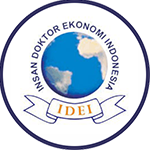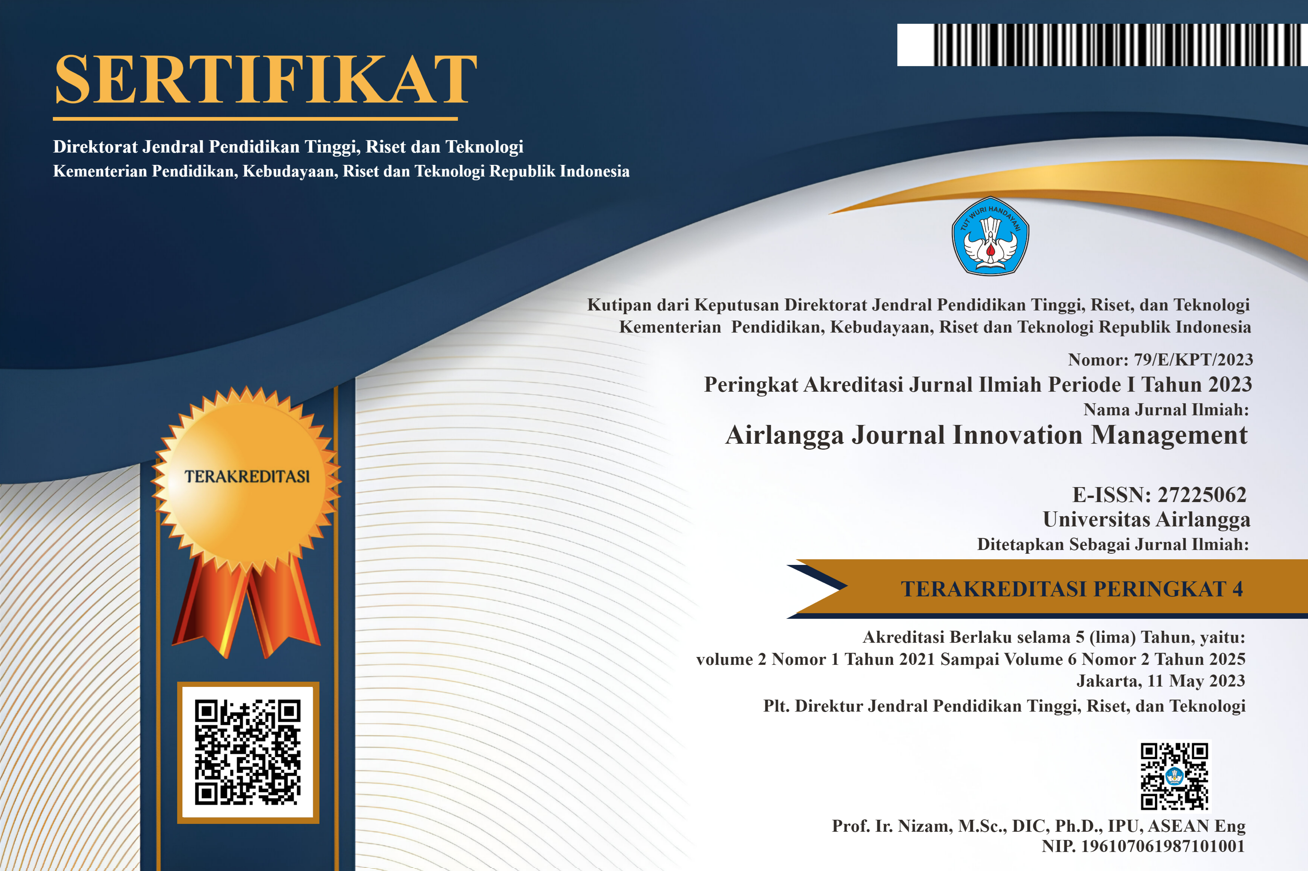HOW DO TRADE, INFLATION, EXCHANGE RATES, AND INFORMATION TECHNOLOGY INFLUENCE INTERNATIONAL TOURIST VISITS IN INDONESIA?
Downloads
This study aims to determine the short-term and long-term effects of trade, inflation, exchange rates, and information technology on international tourist visits in Indonesia. This study uses a quantitative approach within the Vector Error Correction Model (VECM) technique. The data used in this study are annual time series data of Indonesia trade, inflation, exchange rate and information technology on 1991-2019 period. The data used in this study were sourced from World Bank, International Monetary Fund (IMF), and Central Statistics Agency data. The results of the VECM research in the short term show that the variables of trade and information technology have a significant positive effect on international tourist visits. Meanwhile, inflation and exchange rates have a significant negative effect on international tourist visits. Then the results of VECM research in the long term show that variables of trade and information technology have a significant positive effect on international tourist visits. Meanwhile, inflation has a significant negative effect on international tourist visits. This study bring any literature contribution to future study that macroeconomics variables (trade, inflation) and information technology can influence the rise and fall of tourist visits to Indonesia. Practical contributions also brougt by this study as recommendations to increase international tourist visit in Indonesia for government and tourism stakeholder.
Afí«rdita, B.-S., & Mihane, B.-N. (2015). Information Technology and the Digital Economy. Mediterranean Journal of Social Sciences, 6(6). https://doi.org/10.5901/mjss.2015.v6n6p78
Alola, U. V., Cop, S., & Alola, A. A. (2019). The spillover effects of tourism receipts, political risk, real exchange rate, and trade indicators in Turkey. International Journal of Tourism Research , 21(6), 813–823. https://doi.org/10.1002/jtr.2307.
Al-Mulali, U., Solarin, S. A., Andargol, A. E., & Gholipour, H. F. (2020). Digital adoption and its impact on tourism arrivals and receipts. Anatolia An International Journal of Tourism and Hospitality Research, 00(00), 1–3. https://doi.org/10.1080/13032917.2020.1856692
Badan Pusat Statistik. (2019). Statistik Kunjungan Wisatawan Mancanegara 2019. Jakarta: Badan Pusat Statistik.
Basuki, A. T., & Prawoto, N. (2016). Analisis Regresi dalam Penelitian Ekonomi dan Bisnis. Dilengkapi Aplikasi SPSS & EVIEWS. PT RajaGrafindo Persada.
CNN Indonesia. (2021, Maret 28). Daftar Kasus Ledakan Bom di Indonesia 2 Dekade Terakhir. Retrieved Juni 1, 2020, from CNN Indonesia: https://www.cnnindonesia.com/nasional/20210328150157-20-623072/daftar-kasus-ledakan-bom-di-indonesia-2-dekade-terakhir
Crouch, G., & Ritchie, J. (1999). Tourism, Competitiveness, and Societal Prosperty. Journal of Business Research , 44 (3), 137-152.
data.worldbank.org. (n.d.-a). ICT service exports (% of service exports). The World Bank. Retrieved April 7, 2021, from https://data.worldbank.org/indicator/BX.GSR.CCIS.ZS
data.worldbank.org. (n.d.-b). Inflation, consumer prices (annual %). The World Bank. Retrieved April 28, 2021, from https://data.worldbank.org/indicator/FP.CPI.TOTL.ZG
data.worldbank.org. (n.d.-c). International tourism, number of arrivals. The World Bank. Retrieved April 28, 2021, from https://data.worldbank.org/indicator/ST.INT.ARVL
data.worldbank.org. (n.d.). Trade (% of GDP). Retrieved Mei 2021, from The World Bank: https://data.worldbank.org/indicator/NE.TRD.GNFS.ZS
Diphayana, W. (2018). Perdagangan Internasional. Yogyakarta: Penerbit Deepublish.
Gül, H. (2013). Economic Impacts of an Increase in the Foreign Tourism Receipts: a Sam-¬-Based Income Multiplier Analysis for Turkey. An International Journal of Akdeniz University Tourism Faculty , 1(1), 2147–9100. www.ttyd.org.tr.
Haseeb, M., Zandi, G., Andrianto, N., & Chankos, T. (2019). Impact of macroeconomic indicators on development patterns: Case of tourism industry in ASEAN region. Journal of Security and Sustainability Issues , 9(1), 257–268. https://doi.org/10.9770/js.
IDN Times. (2018, Oktober 20). 5 Kejadian Penting di Indonesia Tahun 2000an yang Harus Kamu Ketahui. Retrieved Juni 1, 2020, from IDN Times: https://www.idntimes.com/hype/throwback/zainal-arifin/5-kejadian-penting-di-indonesia-tahun-2000an-yang-harus-kamu-ketahui-c1c2/5
Kompas.com. (2018, September 3). 7 Fakta Seputar Asian Games 2018. Retrieved Juni 1, 2021, from Kompas.com: https://olahraga.kompas.com/read/2018/09/03/14421248/7-fakta-seputar-asian-games-2018?page=all
Hojeghan, S. B., & Esfangareh, A. N. (2011). Digital economy and tourism impacts, influences and challenges. Procedia - Social and Behavioral Sciences, 19, 308–316. https://doi.org/10.1016/j.sbspro.2011.05.136
Ilić, I., & Nikolić, A. (2018). Implications of modern technology development for the tourism sector of the Republic of Serbia. Ekonomika, 64(1), 37–52. https://doi.org/10.5937/ekonomika1801037i
Kumar, N., & Kumar, R. R. (2019). Relationship between ICT and international tourism demand: A study of major tourist destinations. Tourism Economics, 26(6), 908–925. https://doi.org/10.1177/1354816619858004
Leití£o, N. C. (2010). Does trade help to explain tourism demand? The case of Portugal. Theoretical and Applied Economics , Volume XVII, No. 3(544), pp. 63-74 .
Liputan6. (2003, Agustus 5). Lima Ledakan Bom Mengguncang Jakarta pada 2003. Retrieved Juni 1, 2020, from Liputan6: https://www.liputan6.com/news/read/59796/lima-ledakan-bom-mengguncang-jakarta-pada-2003
Lopez-Cordova, E. (2020). Digital Platforms and the Demand for International Tourism Services. Digital Platforms and the Demand for International Tourism Services, February. https://doi.org/10.1596/1813-9450-9147
Mak, J. (2003). Tourism and the Economy: Understanding the Economics of Tourism. University of Hawaii Press.
Mankiw, N. G. (2018). Pengantar Ekonomi Makro (Ketujuh). Salemba Empat.
Meo, M. S., Chowdhury, M. A. F., Shaikh, G. M., Ali, M., & Masood Sheikh, S. (2018). Asymmetric impact of oil prices, exchange rate, and inflation on tourism demand in Pakistan: new evidence from nonlinear ARDL. Asia Pacific Journal of Tourism Research, 23(4), 408–422. https://doi.org/10.1080/10941665.2018.1445652
Neidhardt, J., & Werthner, H. (2018). IT and tourism: still a hot topic, but do not forget IT. Information Technology and Tourism, 20(1–4), 1–7. https://doi.org/10.1007/s40558-018-0115-x
Purba, B., & Suryani, D. (2021). Ekonomi Internasional. Yayasan Kita Menulis.
Putong, I. (2003). Pengantar Ekonomi Mikro dan Makro. Ghalian Indonesia.
Rozalinda. (2017). Ekonomi Islam, Teori dan Aplikasinya pada Aktivitas Ekonomi. Rajawali Pers.
Shahbaz, M., Kumar, R., Ivanov, S., & Loganatha. (2017). The nexus between tourism demand and output per capita with the relative importance of trade openness and financial development: A study of Malaysia. Tourism Economics , 23(1), 168–186.
Simorangkir, I., & Suseno. (2005). Sistem dan Kebijakan Nilai Tukar. Jakarta: Pusat Pendidikan dan Studi Kebanksentralan (PPSK) Bank Indonesia.
Song, H., & Li, G. (2008). Tourism Demand Modelling and Forecasting: A Review of Recent Research. Tourism Management , 29 (2): 203-20.
Sugiyono. (2016). Metode Penelitian Kuantitatif, Kualitatif dan R&D. Cetakan ke-23. Afabeta.
Tampubolon, J. (2020). Perdagangan dan Bisnis Internasional Teori dan Analisis Empiris. Yogyakarta: Penerbit Deepublish.
TTCI. (2019). The Travel & Tourism Competitiveness Report 2019. Geneva: The World Economic Forum's Platform for Shaping the Future of Mobility.
UNWTO. (n.d.). Global and Regional Tourism Performance. Retrieved April 2021, from The World Tourism Organization: https://www.unwto.org/global-and-regional-tourism-performance
Utami, R. C., & Hartono, D. (2016). Analisis Daya Saing Harga Pariwisata Indonesia: Pendekatan Elastisitas Permintaan. Jurnal Kepariwisataan Indonesia , Vol. 11 Nomor 93-118.
unwto.org. (n.d.). Global and Regional Tourism Performance. Retrieved April 18, 2021, from https://www.unwto.org/global-and-regional-tourism-performance
Wang, L., Zeng, G., & BI, D. (2019). Spatial spillover effects of ICT on tourism industry growth. Acta Geographica Sinica , 74(2), 366–378. https://doi.org/10.11821/dlxb201902012.
World Travel & Tourism Council. (2020). TOP 20 ECONOMIES - LARGEST CONTRIBUTION OF TRAVEL & TOURISM GDP. https://wttc.org/.
Yalçinkaya, Ö., Daştan, M., & Karabulut, K. (2018). The effects of international tourism receipts on economic growth: Evidence from the first 20 highest income earning countries from tourism in the world (1996-2016). Montenegrin Journal of Economics, 14(3), 55–71. https://doi.org/10.14254/1800-5845/2018.14-3.4

This work is licensed under a Creative Commons Attribution-NonCommercial-ShareAlike 4.0 International License.
- The journal allows authors to hold copyright without restrictions and retain publication rights without restrictions. The author retains the copyright and grants the first publication rights to the journal, with his work simultaneously licensed under the Creative Commons Attribution-NonCommercial-ShareAlike 4.0 International License (CC BY-NC-SA). This license allows others to share the work with acknowledgment of authorship and initial publication in this journal, provided that the work is not used for commercial purposes and that any derivative works must use the same license.
- Authors may enter into additional contractual agreements for non-exclusive distribution of the journal publication version (e.g., uploading it to an institutional repository or publishing it in book form), while still including acknowledgment of the initial publication in this journal.
- Authors are allowed and encouraged to upload their work online (e.g., in an institutional repository or personal website) before and during the submission process. This can support productive scientific exchanges as well as increase citations to published works.

AJIM by UNAIR is licensed under a Creative Commons Attribution-NonCommercial-ShareAlike 4.0 International License.





















